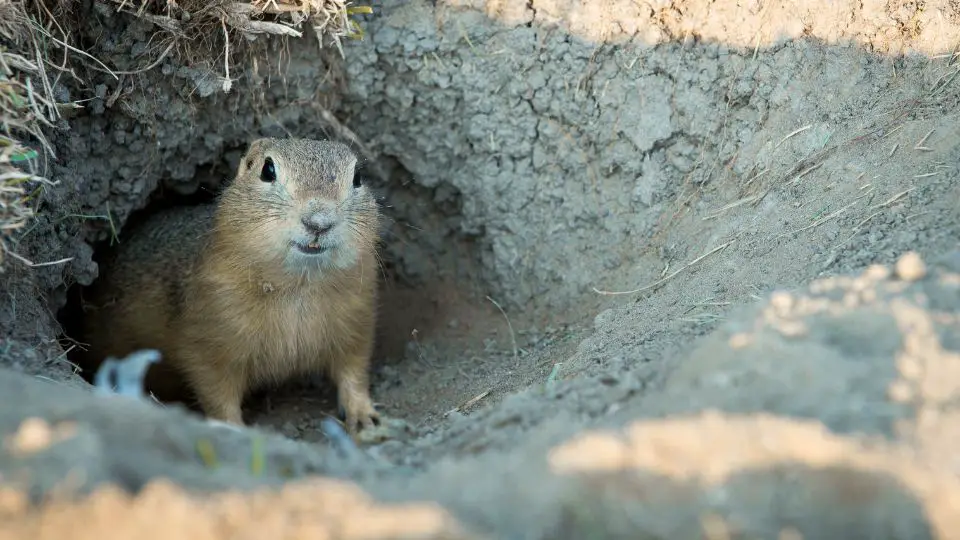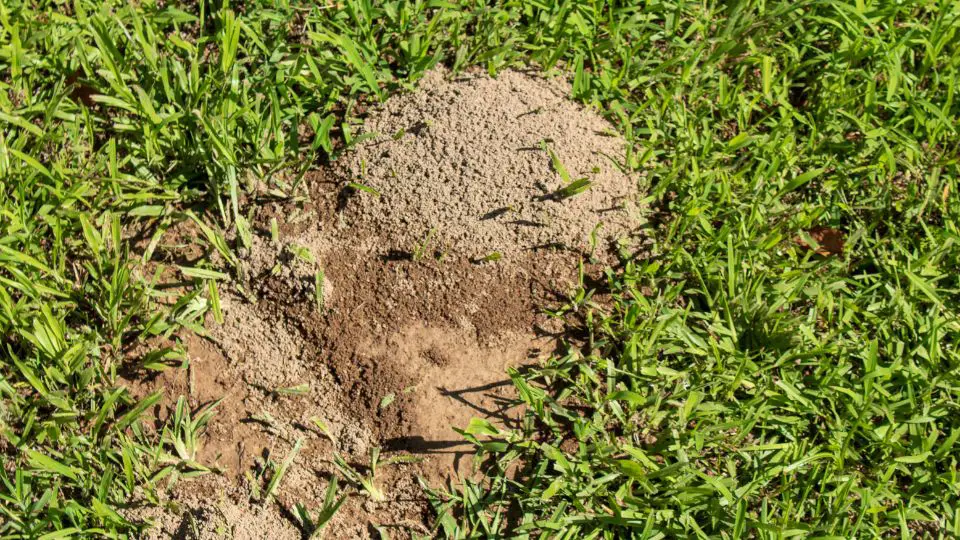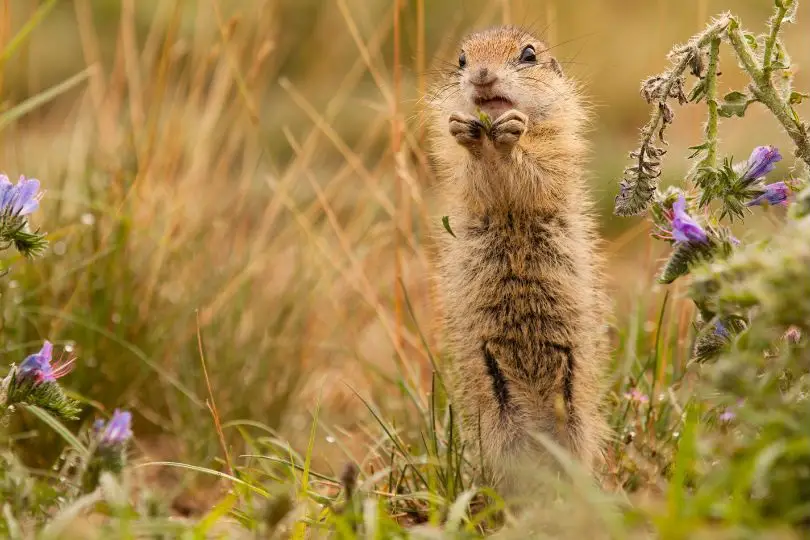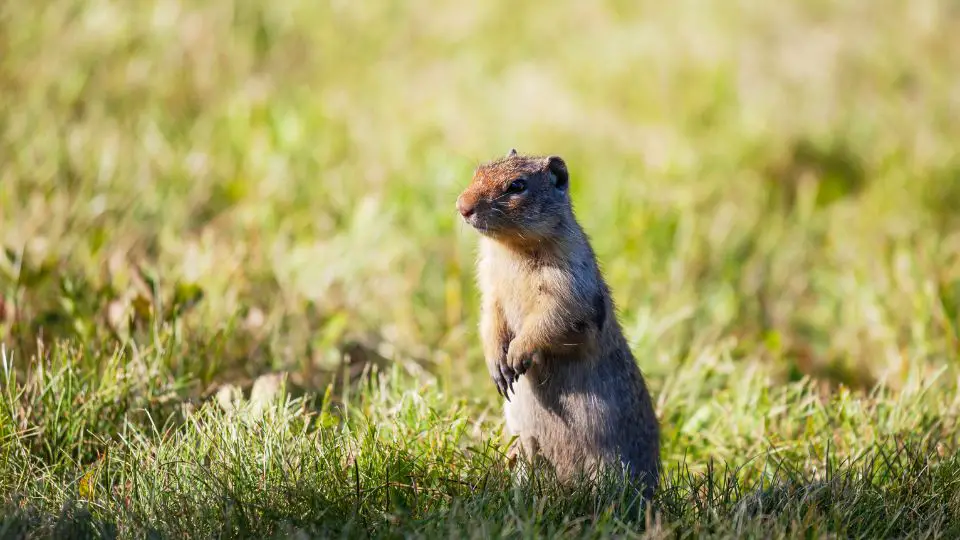Gophers holes and mounds are typically heart-shaped, crescent-shaped, or horseshoe mound of scattered dirt. Gophers usually close their holes after digging.
Countless pests can destroy your garden and lawn, but none does it better than the vole, mole, and gopher. These critters can transform your neatly and perfectly manicured lawn into a maze of holes, tunnels, and mounds.
It’s difficult to tell these pests apart, but they’re different. The treatment measures and products depend on the type of pest occupying your yard and garden.
Therefore, identifying the critters in your garden, the signs they leave behind, and the type of tunnels will lead to a faster treatment process and a much healthier lawn. This guide will assist in identifying gopher holes.
Table of Contents
What does a gopher look like?
Gophers usually range between four to twelve inches in length.
Compared to a vole or mole, gophers are physically larger and cause more damage to your lawn, yard, and garden. They’re commonly known as pocket gophers due to their massive cheek pouches to hold nesting materials and food.
They have two large incisor teeth on both the top and bottom jaws. Gophers have sharp claws that help them burrow underground and whiskers that guide them in the dark tunnels.
Gophers are destructive animals that can have been known to destroy underground sprinkler systems, cables, and irrigation systems. Most of their activity is witnessed in the fall and spring when they’re most active.
They also burrow near the surface, making it easy to confuse them with moles and voles. Commonly found throughout North America, you can easily confuse a gopher, a groundhog, a ground squirrel (Spermophilus), a mink, or a groundhog because of their small stature and burrowing nature.
Because of their burrowing nature, moles and gophers are challenging to spot. However, you don’t have to see them to tell them apart physically. You can actually distinguish them from their hole making.

What does a gopher hole or gopher mound look like?
So, what does a gopher hole look like? If you suspect a gopher in your yard or garden, their holes will likely have the following features:
- Dumped dirt: Gophers usually dump the excess dirt after building the tunnel
- Closed holes: Gophers permanently close the openings of their burrows even after a slight disturbance.
- Crescent mound of dirt: You can easily distinguish gopher holes due to their crescent-shaped mounds of dirt in the garden or yard
- For gophers, the plug typically shows a slight dip in the mound.
This is especially evident near the center or to the mound’s side. Besides, the soil in the mound is usually in bigger chunks compared to that of a mole.
What is the difference between mole and gopher mounds?
Let’s look at gopher mounds versus mole mounds. Moles typically make cone or volcano-shaped mounds. The soil found on the mound is usually finer than that of a gopher’s.
Moles seldom come out of their tunnels and only poke a hole in the ground and push the diet straight up, creating a cone or volcano-shaped mound. Mole mounds are also smaller, around eight inches high and two feet in diameter.
Can you fill in a gopher hole?
You can repair your landscape damage from gophers by filling the gopher hole.
Fill in the hole with soil on top of the yard or flowerbed. Avoid adding gravel like lawn repair; refill the hole with the existing soil and then add topsoil to level the ground with the neighboring area.
However, in the grass, you can fill the bottom of the tunnel with gravel and then add topsoil on the top. Another idea is flooding gopher tunnels with water, but it doesn’t guarantee success and harms your lawn.

Do gophers leave their holes open?
Gophers tirelessly work on extending their underground tunnels and burrows. They often leave the entrance hole open until it finishes the day’s work before plugging the door with soil.
If you see a gopher hole open, this could mean they’re gone. Blocking the gopher hole is their only defense against predators and water and keeping their scent inside.
Why do gophers dig so many holes?
Gophers are known to dig many holes to allow them to feed without being too far from the entrance. This limits the time exposed on the surface, thus lowering the chances of becoming prey.
Since they do spend most of the time underground, the many holes include waste holes, drainage tunnels, nesting areas, and food storage, allowing them to exist comfortably. Other holes are used to get rid of the excess soil and plug them for safety.
Do gophers tunnel under the house?
Gophers can tunnel under your house, adversely weakening the integrity of your property and causing the land to cave in. One gopher burrow can have around 200 yards of tunnels.
These can stretching anywhere from two hundred to two thousand square feet. The nesting area can be approximately 6 inches to 6 feet underground.

What to do if you identify gopher holes and burrows?
As mentioned above, gophers can tunnel under your house, and undermine your foundation. Therefore, you want to keep these pests at bay.
One of the best and most effective home solutions to get rid of gophers is to use castor oil:
- Mix one part dish soap and three parts castor oil
- Add several tablespoons of the mixture to a gallon of water
- Soak the holes to evict the gophers
Other methods to prevent gophers from accessing your yard include:
- Wire mesh
- Plastic netting to protect seedlings and seeds
- Raised gardens to prevent gophers from accessing your plants
- Repellents or traps

